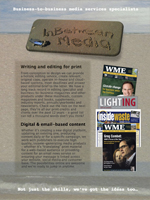
An image often used to accompany media reports on climate change science. But what does it mean to different people?
On reviewing criticism and analysis of the mainstream news media’s reporting and positioning of climate change, it’s clear that it’s not just concerned with perennial discussions about impartiality, objectivity, the role and ownership of the media. It’s about an unprecedented challenge, one that involves future scenarios, detailed scientific reasoning and a gas which although invisible manages to incite messianic debate.
The issue of climate change also permeates almost every traditional ‘silo’ of journalism, albeit often presented as an environmental or science issue. But future reporting in the area could take a broader focus if awareness and acceptance grows of the expected effects of global warming.
“Politicians, scientists, and policy makers are increasingly using the concept and language of risk in a context of uncertainty to frame what is probably the greatest challenge this century, human-induced climate change,” writes James Painter from the Reuters Institute for the study of journalism, in Climate change in the media: reporting risk and uncertainty.
He points out that climate change is a health issue, economic issue, social and business issue, to name a few under-explored areas of mainstream news media coverage.
Influence of business
There is emerging dialogue and action within progressive business circles, referred to as climate change adaptation, which is being considered by ‘green’ and ‘non-green’ companies alike as a strategic issue. This may cut in at the level of corporate governance, risk assessment, or management and upgrade of assets.
For instance, retailers and resources companies with long planning time frames are beginning to consider different climate change scenarios in how they manage assets. Some large shopping centre owners are seeing the opportunities to provide vital services to groups in surrounding areas that are vulnerable to extreme weather events, as well as benefit from increased patronage during heat waves for instance. Companies are working with community groups to respond to urban heat island effect and address the potential impacts this has on workplace health and safety and property values.
If the same shift occurs in public sentiment towards climate change and/or the way that mainstream media covers the issues, then it would engage a much broader group of people. It’s clear that a shift of focus from carbon abatement or validity of climate science, to the multiple benefits of more efficient, community run energy enterprises, diversifying regional income, improving food production and supply chains, involves more people than just ‘greenies’ and their adversaries.
One agency that is attempting to “have a conversation” around the sustainability of Australian society, including climate change impacts, is the National Sustainability Council. Its mandate is to report against a critical set of sustainability indicators every two years, the first instalment of which was released earlier this year.
It reads, “A crucial sustainability issue for all Australians is the extent to which our food supply chain is resilient in the event of a crisis or emergency. For example, during the Queensland floods … Rockhampton (with a population around 75 000) was cut off by road, rail and air for two weeks, and Brisbane came within a day of running out of bread for its population”.
The National Sustainability Council is attempting to position sustainability as “something we all have responsibility for”, not just polluting industries or problems discussed far away from Australian soil.
Launching the Council’s inaugural report, Professor John Thwaites, Chair of the National Sustainability Council, said, “We hope that this report will stimulate conversations in kitchens, in coffee shops, in offices and over dinner about the kind of place Australians want to be calling home in 20 years and beyond”.
It can be argued whether they achieved their aim, due in part to the lack of media coverage and it’s worth examining why given the similar fate of communications from the Climate Commission, the Climate Change Authority and others.
Whether we will see another report against the same sustainability indicators is uncertain after Prime Minister Tony Abbott’s recent announcement that the Council will be “absorbed” into the environment department’s portfolio. It is one five non-statutory bodies that will be dealt with likewise. A further 12 non-statutory bodies will be abolished, following the dissolving of the Climate Change Commission earlier this year.
Changing the ‘narrative’
“One of the arguments in favour of using the language of risk is that it shifts public debate away from the idea that decisions should be delayed until conclusive proof or absolute certainty is obtained,” says Painter.
This addresses one of the criticisms levelled at the mainstream news media’s coverage of climate change issues, which is the low level of analysis of the comparative costs and risks of different choices.
Painter’s examination of around 350 articles in three newspapers in each of the six countries with a combined circulation of at least 15 million, showed that the dominant messages readers received were predominantly ones of disaster or uncertainty.
“The one major exception to the lack of variation between the six countries was the presence of uncertainty through sceptical voices: Australia had the highest number of articles in the sample with sceptics in them and the highest percentage of articles, followed by the USA.”
In 2011 and 2012, the Australian Centre for Independent Journalism at University of Technology, Sydney collected data on climate science coverage in ten Australian newspapers. Its recent report found that one third of articles in Australia’s major newspapers do not accept the consensus position of climate science: that human beings are contributing to climate change.
“Australia’s two biggest newspapers by circulation, News Corp’s Daily Telegraph and Herald Sun, were more than 60% sceptical about anthropogenic climate change,” says Wendy Bacon, a Professor of Journalism based at the Centre.
In contrast, Fairfax Media, owners of The Age and Sydney Morning Herald accepts the consensus position and published very few articles that communicated doubt about anthropogenic climate change.
It’s expected that the ‘doom and gloom’ climate change stories will have continuing appeal to media outlets, and those framed within the vociferous political debate in the Australian context. However, Painter suggests that journalists are going to become more exposed to “the language and the concept of risks in covering climate science”.
He says, “Numbers and probabilities are likely to become more important in the coming years: as climate models become more powerful and sophisticated, their potential to quantify uncertainties and generate probabilistic climate projections will be enhanced”.
What he’s suggesting is that uncertainty will be measured in more helpful ways as a basis for making decisions, even though it will not be eliminated.
The most recent report from Intergovernmental Panel on Climate Change does go further than the previous one in its confidence in the science of global warming, stating it’s 95 per cent likely that human activities are the main cause of warming since the 1950s. But they are finding it harder than expected to predict the impact in specific regions in coming decades, hence the need for journalists to understand the processes involved and their importance to decision making.
Reporting problems
One of the central criticisms of mainstream news media coverage of climate change is the rigid adherence by editors and proprietors to the practice of balanced coverage. That is giving ‘airtime’ to both sides or multiple sides of an issue.
“So a consensus in science is different from a political one. There is no vote. Scientists just give up arguing because the sheer weight of consistent evidence is too compelling, the tide too strong to swim against any longer,” says research fellow in climate communications at the Global Change Institute University of Queensland, John Cook.
Therefore, balanced coverage of science requires that each argument must be given weight according to the balance of evidence.
One way that journalists and editors have chosen to deal with this issue most recently is to ban certain views held by climate sceptics from their publications, more specifically from their letters pages.
Los Angeles Times letters editor, Paul Thornton wrote in October, “Simply put, I do my best to keep errors of fact off the letters page; when one does run, a correction is published. Saying “there’s no sign humans have caused climate change” is not stating an opinion, it’s asserting a factual inaccuracy”.
While it’s not new for media operators to maintain accuracy on their letters page, many interpreted this piece as taking a stand on silencing climate naysayers.
Since then The Guardian’s Graham Readfearn has offered up an analysis piece, which touches on a related issue of online forums or comments on media stories. He reports that the US magazine Popular Science is removing the ability of readers to comment on its online stories due to concerns that “trolls and spambots” could “skew” their readers’ understanding of the issues.
Anyone who has stopped by The Conversation recently, will recognise the same problem of largely anonymous hijacking of forums that any story, even scantly related to climate change, produces.
Five days after Readfearn’s piece, a story appeared on the Sydney Morning Herald’s website, stating editor-in-chief Darren Goodsir’s policy that letters stating “there is no sign humans have caused climate change would not make the grade for our page”.
According to Bacon, “This issue is not one of free speech or the right of a few individuals to push their ideas, but of the market power of a dominant company to build support for particular policies and ideas”.
It’s also about the need to explore different tools to communicate climate change and perhaps a less comfortable role for the media, in framing how we ‘imagine’ climatic futures.
Writing about the work of John Cook and oceanographer John Church, Monash University’s David Holmes said, “What Cook and his group have hit upon is that abstract climate change processes are best explained by memes, icons and social memories that make the physics involved meaningful to people”.
What they found was that the equivalent of the heat released by 345,600 Hiroshima bombs is absorbed by the earth every day, or four bombs every second. Ninety per cent of the heat released by those bombs is going into the ocean.
“The Cook team measured the amount of heat the oceans have absorbed in Joules. In terms of visualising warming, Joules are not very meaningful. So the team chose to convert ocean warming into a release of energy etched into the collective memory of the 20th century,” said Holmes.
There is also the opportunity for media operators to work with other organisations in engaging society in imagining climate change and shaping a more sustainable future.
Remind me why this matters
It’s widely acknowledged that we need to keep climate change below 2C to avoid catastrophic impacts on society. Research and experience has shown that we need to find more effective ways of communicating climate science that overcome traditional limitations of the journalistic business model and political agendas.
But with Australia’s largest media company, News Limited, and the government both in agreeance that climate change is real, what’s the problem?
Actually, it’s not clear where Tony Abbott and the Coalition sit philosophically on climate change. Abbott has expressed a variety of views, his government is repealing carbon pricing legislation and dismantling various public agencies reporting on climate change science, supporting sustainable activities and emissions targets. While this can be seen as an efficiency drive it also demonstrates the government’s prioritisation of climate change.
The government’s commitment to cutting emissions by 5 per cent from 2000 levels by 2020 is seen as increasingly tokenistic. In a draft report on emissions reduction targets, the Climate Change Authority, which is itself facing closure, says Australia’s emissions reduction target is inadequate and lagging behind the rest of the world. But the government is unmoved, choosing to wait on the possibility of a binding international emissions reduction target in 2015, before reviewing domestic policy.
As for News Limited, Bacon summed it up in an interview on October 31:
“In the Guardian today … News Corp has said they accept the consensus [scientific consensus on anthropogenic climate change], it’s up to their editors. And in fact some of their editors have said they accept the consensus.
“Well if they accept the consensus why are they providing this strategic role to a person who is actually abusive of climate scientists. It’s not that he’s just not reporting their views… he says it in a factual way that they are lying,” she said, referring to prolific Herald Sun columnist Andrew Bolt, who writes more than half of all the words on climate science in the newspaper which are also syndicated around Australia.
It’s important to remember that it’s the mainstream news media we’re talking about here, just one piece of the media pie. There are numerous specialist media publications and websites that are ‘filling in the gaps’ for those readers who want to understand more about climate change.
As information and information-making becomes more fragmented, the news giants lose their dominance and with it often their specialist writers, people will look to a diverse range of sources to satisfy their need to know.
© 2013 InBetween Media


Comments are closed.